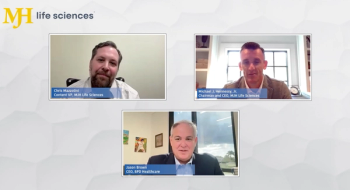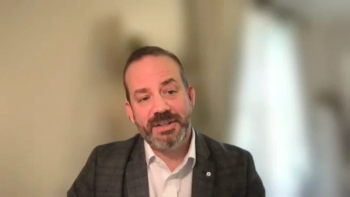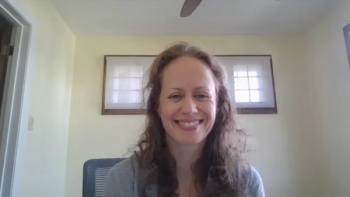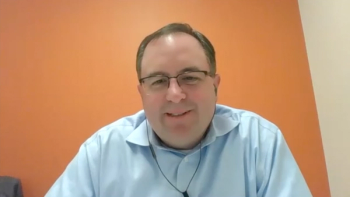
PX: Who is Responsible for Driving Healthcare Innovation?
We can make sense of the constant push and pull between physicians, executives, pharma, technocrats, government agencies and more.
Innovation is the fuel that will drive healthcare into a more outcomes-oriented future. But who should be held accountable for driving innovation? Better yet, who's qualified? We've all heard the complaints: Many doctors are too caught up in practice to innovate, and many hospital executives are too out of touch with practice to innovate correctly.
So where does that leave the onus? Our expert panel weighs in:
Who is Responsible for Driving Healthcare Innovation?
A Healthcare Analytics News® Peer Exchange®
Segment 11/13
Kevin R. Campbell, MD: I think that we lack real leadership in healthcare systems, and I keep saying this: It’s because the doctors, who are the centers of the healthcare system with the patients, have been blocked out. And now, we have these guys with their shiny MBAs and their shiny MPHs who are there running healthcare systems, and they’ve never seen a patient. They don’t understand what it’s like to be a patient, a nurse, or a physician.
John Nosta, BA: Let me shine a light on that frail ego of the physician.
Kevin R. Campbell, MD: It’s not an ego thing.
John Nosta, BA: Let me tell you something. Let’s talk about the AMA [American Medical Association]. Let’s talk about physician lobbying groups and the monolith that exists called clinical medicine. It’s a structured hierarchy.
Geeta Nayyar, MD, MBA: John, I’m going to interrupt you. I’m going to interrupt you because you would never go into the educational industry and tell a teacher what to do. You’ve got to talk to the end user.
John Nosta, BA: What? You do all the time. The NEA [National Education Association] completely dominates curriculum.
Kevin R. Campbell, MD: Let me also make 1 correction. The AMA represents less than 13% of practicing licensed physicians. The AMA is political organization…
John Nosta, BA: And their share of voice is 13%?
Kevin R. Campbell, MD: That has their hands in the pockets of Congress. Everybody on the AMA is making money at the expense of physicians, nurses, doctors, and hospitals in this country.
John Nosta, BA: But look, Kevin, when you go on rounds and you have a pecking order, there’s still a tremendous hierarchy where the chief of medicine comes in and then speaks to the fellow who speaks to the medical student or the intern. There’s a real hierarchy there. I think that physicians protect that hierarchy, and I think that’s got to be broken. Now, why? Because the pharmacist may be the most valuable caregiver in the dynamic today, or the nurse may be. I think that the sacrosanct physician is very tricky.
Kevin R. Campbell, MD: I would invite you to go on rounds with us at Duke because when we make rounds, we make rounds with medical students, interns, residents, fellows, pharmacists, pharmacy residents, social workers, and physical therapists. They are with us, together.
John Nosta, BA: Who only speak when they are spoken to.
Kevin R. Campbell, MD: I would disagree. We have multidisciplinary rounds. When I was an intern at UVA [The University of Virginia], we had to sit in a room as an intern with all the ancillary and listen to their needs, so I understood.
Geeta Nayyar, MD, MBA: Which is very different from a board room, by the way.
John Nosta, BA: I think it’s less different because you’re on the inside. You’re already there. You’re part of the problem.
Geeta Nayyar, MD, MBA: No, no, I’m able to see it from both sides. That’s absolutely incorrect, and I think that’s the beauty of what Kevin’s saying. You’ve got to engage the end user. That was a brilliant example because you have every end user at the table taking care of one patient. How often does that happen in Corporate America, where all these decisions are being made by pharmaceuticals, health systems, payers, and policy makers? We have great policy makers that make great policy for themselves.
John Nosta, BA: But let’s just not cast aside the physician as the sacrosanct job that is not in question here.
Geeta Nayyar, MD, MBA: The EMR [electronic medical record] industry. With the entire EMR evolution that happened in healthcare, there is a reason that every doctor hates every EMR out there. They were never built with the end user in mind.
Kevin R. Campbell, MD: They were built with billing capture in mind, that’s it.
Geeta Nayyar, MD, MBA: They were built, and they were successful because of policy regulation, not because they were great pieces of technology. You buy an Apple product and you use Google because they’re good and don’t require any training. Do you know how much training I’ve had on Allscripts, eCW [eClinicalWorks], or Cerner?
Kevin R. Campbell, MD: We shut down our practice for seven days, for eight hours a day, to learn how to use some stupid billing machine.
Geeta Nayyar, MD, MBA: If you had to stop working for seven days so you could figure out how to use your phone, would you use it?
Kevin R. Campbell, MD: In my regular clinic, I see 45 patients in a full day. For three months while we were implementing Epic, I saw seven in the morning and seven in the evening.
Geeta Nayyar, MD, MBA: And how much did that cost you?
Kevin R. Campbell, MD: Me personally, I have no idea.
Geeta Nayyar, MD, MBA: And how much did your patients suffer?
Kevin R. Campbell, MD: I couldn’t get anybody in. I could not get anybody in.
Geeta Nayyar, MD, MBA: It sounds like a great piece of technology.
John Nosta, BA: Turn around, face the other direction. Stop looking back at the spilled milk. Look forward. The promise of the EMR and technology will give you more time with your patients.
Geeta Nayyar, MD, MBA: John, that’s why I’m doing what I’m doing. I think it’s so important to have that perspective, and not from a doctor who drank the Kool-Aid but the average doctor, the one out there in middle of America in urban areas, the person who’s actually in the emergency room, running an office, or running a practice. Anyone who wants to disrupt or innovate, I welcome them.
John Nosta, BA: So, you don’t think physicians are part of the problem?
Geeta Nayyar, MD, MBA: I think that every stakeholder is.
Kevin R. Campbell, MD: Oh, I do.
John Nosta, BA: A big part of the problem. No, I’m not talking about other stakeholders, I’m talking about physicians.
Geeta Nayyar, MD, MBA: No different from pharmaceuticals, no different from any other stakeholder in this system.
John Nosta, BA: Really? They’re the front line of defense.
Geeta Nayyar, MD, MBA: They don’t even have a seat at the table.
Kevin R. Campbell, MD: They don’t. But the issue with physicians, I said it earlier, is they’re slow to adopt change and we have to change that. You can no longer exist in a separate orbit around digital innovation. I would argue that physicians in my cohort, and younger physicians, are moving that direction. As for my senior physicians, the ones who taught me, I still can’t get Eric Prystowsky to get on Twitter. I begged him. I told him I would set him up and he said, “I can’t do it.”
Jane Sarasohn-Kahn, MA, MHSA: Time will solve that problem.
Geeta Nayyar, MD, MBA: Listen, I went to medical school and Kevin went to medical school because we wanted to see patients. We like science, we like people, and we said, “I want to take care of patients.” I didn’t go to medical school because I wanted to learn how to use Epic or to get on Twitter. It wasn’t about that. It’s about being a doctor, and if something will help me do my job better, I’m open to it. If it’s going to make me shut my office down for seven days, only to slow me down so I can’t see my patients, why should I?
John Nosta, BA: Listen, if you really want to get into the psychopathology of clinical practice today, let’s take a survey of those undergraduates who are premed and want to become doctors. How many of them want to become a doctor because they want to care for patients? I think that’s a retrospective, feel-good-about-yourself construct. I think it’s more complicated than that, that’s all.
Geeta Nayyar, MD, MBA: I think if we’re talking about disruption today, the only way to disrupt in healthcare is to talk to the end user. Whether it’s the patient model you’re trying to change or whether it’s the provider side you’re trying to change, you have to talk to the end user—that’s all I’m saying—independent of the industry. Even if we weren’t talking about healthcare.
John Nosta, BA: Maybe, maybe. I’m going to say one thing, and I promise I’ll be quiet. In developing CRISPR technology, if I want to use gene therapy or if I want to develop a new immuno-oncology off-the-shelf concept that doesn’t cost $475,000, should I talk to the consumer? I don’t believe that’s the case. I think with respect to market access, with one leg, every single pharmaceutical company today has the same tagline: “Customers first, the life of the patient.” I think they’re missing the ball. They’re not keeping their eye on the nature of scientific innovation and discovery. Of course, the patient is important, but the guys working on CRISPR and immuno-oncology have a different world view. I think that we have to respect both of them.
Colin Hung, BaSC: I hear this talk about involving physicians, patients, and all these folks, and I think it is something that innovators have to do or should do. Having spoken to a lot of companies and working with them a lot, I think the problem is that they want to but can’t get access. It is almost impossible to get the ear of a physician to even lend them some expertise such as, “Can you just comment on what I’ve built?” I’m thinking about this.
Kevin R. Campbell, MD: I hear you, 100 percent.
Colin Hung, BaSC: It is virtually impossible for them to get on people’s radar. You may be an exception.
Geeta Nayyar, MD, MBA: And they’re too busy trying to figure out their EMR.
Colin Hung, BaSC: That’s right, they’re busy practicing. They have no time for innovation, not because they don’t want to but because the system isn’t allowing for it. I find it very difficult. I work with them. They’re frustrated that they cannot get access to all of those stakeholders.
Geeta Nayyar, MD, MBA: I’ll give you an example of a great company doing this, Modernizing Medicine.
Colin Hung, BaSC: Sure.
Geeta Nayyar, MD, MBA: They have an EMR, specialty specific. I have no skin in the game, but they have actually hired ENT [ear, nose, throat] physicians, dermatologists and cardiologists. Do you know what they do? If you come in for two days and consult with them, they will pay you whatever you make in two days at your practice.
Colin Hung, BaSC: Modernizing Medicine is amazing.
Geeta Nayyar, MD, MBA: It’s beautiful.
Colin Hung, BaSC: But look at the size you have to be in order to do that. You’re going to pay a physician for their time of the day.
Geeta Nayyar, MD, MBA: There’s no reason Epic, Cerner or any of the big companies can’t do that.
Colin Hung, BaSC: I’m not talking about those, I’m talking the smaller ones because that’s where a lot of the innovation is happening. It’s the startups.
Geeta Nayyar, MD, MBA: Modernizing Medicine started.
Colin Hung, BaSC: But they were physicians.
Geeta Nayyar, MD, MBA: Exactly. Do you know why? Because a physician was a founder of that company. That’s the point. John, I know your head is exploding right now.
John Nosta, BA: What?
Colin Hung, BaSC: I’m with John in this. Are we then forcing every healthcare innovator to be physician founded? I would say no. There should be technicians, there should be engineers.
Geeta Nayyar, MD, MBA: It depends on the end user. If you’re going to build a technology for a physician, yes, you have to have a physician at the table. If you’re building a technology for the payer or for the patient, then you’ve got to go talk to them.
Colin Hung, BaSC: The challenge I’m putting out there is if you’re designing something for a physician, I have asked and tried to get a physician at the table, and they’re not coming, then what are you going to do? Are you going to sit on it? That’s a challenge.
Kevin R. Campbell, MD: I fully admit that. That’s why the Affordable Care Act was put in place the way it was, because doctors buried their head in the sand and said this will never pass. If doctors had come to the table—and admittedly, we weren’t invited as much as we might have been, but we were invited—we might have had a different healthcare system in the United States right now.
Geeta Nayyar, MD, MBA: We were invited after the party got started. I think it was almost over. It was in the last 10 minutes, “Do you want to stop by?”
Jane Sarasohn-Kahn, MA, MHSA: I don’t know, the American Hospital Association and pharmaceuticals wrote a good deal of that bill.
Kevin R. Campbell, MD: Yes, they did.
John Nosta, BA: They did.
Jane Sarasohn-Kahn, MA, MHSA: And if you look at the way the bill resulted, it benefitted hospitals and pharmaceuticals.
Get the best insights in healthcare analytics directly to your inbox with our newsletter.
Related:








































